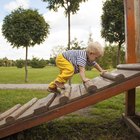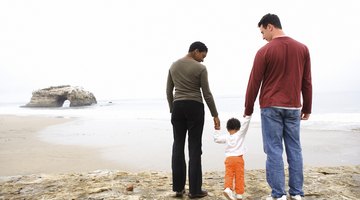Crab Crawling in Infants
Any parent or pediatrician can tell you that there is more than one way for a baby to crawl. As discussed by the National Center for Infants, Toddlers, and Families on its Zero to Three website, the "army crawl" is common, as is the traditional knee-to-hand motion that babies typically exhibit. NCITF also recognizes another infant crawling method -- the crab crawl. As a precursor to walking, the crab crawl operates just like other methods the infants use.
However, the crab crawl does have its critics and is often mistaken for a sign of developmental issues in infants.
This turns what is supposed to be a milestone in the baby's life into a worry for misguided parents. Fortunately, a little knowledge about the crab crawl can dispel any worries.
Doing the Crab
NCITF describes the crab crawl as a movement that begins with the baby settling on all fours -- the hands and feet. He places weight on one leg, while bending the opposite leg to propel himself forward, using the hands to maintain direction and control. The baby will use both legs depending on the direction in which he intends to go (forward or backward). The next step to crab crawling is propelling the body to a stationary, tall object.
The baby will then pull himself up, using the legs to support his upper body into an upright position. Once steady, walking will commence.
Signs of Problems

Developmental Milestones Related to Climbing
Learn More
Contrary to belief, crab crawling in infants is not a sign of a cognitive, developmental or social problem alone, according to NCITF, in an online document titled, "Jeepers Creepers: Your Baby Is Learning to Crawl."
It is a perfectly normal precursor to the walking process for any infant, no matter what her ability level, cognition or gender may be. The only time when there is a problem is when the crab crawl is asymmetrical, says NCTIF. When the baby favors one side of the body over another (one dominant leg or arm that impedes smooth forward motion usually), there may be other problems that a doctor should address. The organization pinpoints asymmetrical crawling as one of the signs of autism in babies.
Duration of the Crawl
Some parents fret over the brevity of their baby's use of the crab crawl for mobility. Some crab crawlers, as does any other crawler, may only briefly display their new skill, before skipping on to the next step, which is walking. The duration of the crawling period actually has no bearing on the infant's ability or development, according to NCTIF. In fact, the organization acknowledges that some babies skip the crawling process altogether, going to the walking stage with no transition at all.
Importance of Tummy Time

Infant Hand Grasp & Development
Learn More
Parents have no way of knowing which type of crawling method their babies will use on the way to walking, when the time comes.
The only thing that parents can do is encourage tummy time to ensure that baby does some sort of crawling before he begins to walk. If there is any concern over the baby's crawling tendencies, only a doctor can say for sure if there is, or isn't, a problem.











